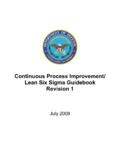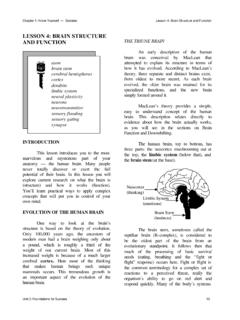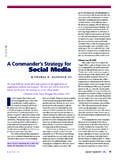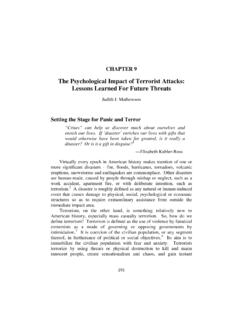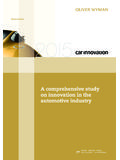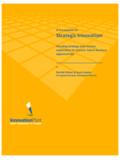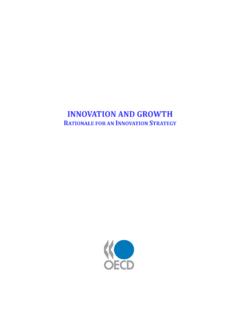Transcription of Chapter 14. Innovation - Air University
1 Chapter 14. Innovation1. By Kathryn A. Baker If defined broadly, Innovation can be seen as the business of science organizations. However, like most of the organizational literature, the Innovation literature has largely focused on Innovation in private sector business organizations. This literature may, nonetheless, have insights that can be used by the science organizations, both private and public. First, although science organizations need to innovate, they have not necessarily taken the lead in systematically studying how organizational and environmental factors can best promote Innovation . Also science organizations in both the private and public sector are under greater pressure not only to generate innovative science but also to function as a business.
2 For example, there is greater emphasis on commercializing scientific discoveries, having a solid and well-designed portfolio of science programs and projects that help the organization adapt to external changes in funding priorities, and demonstrating results and favorable cost/benefit ratios. This Innovation literature may provide insights into balancing Innovation with business realities. While the literature on Innovation in private sector organizations may be a source of useful insights, it may also be the case that studying science organizations could provide critical insights into how to promote and sustain Innovation in private sector business organizations. Public science organizations should consider playing a lead role in promoting strategies for encouraging and sustaining Innovation and developing a true Innovation competency.
3 Overview The literature on Innovation has a long history. The early research on Innovation tended to address the organization's ability to respond and adapt to external and/or internal changes (Burns and Stalker 1961; Hull and Hage 1982). Subsequent work on Innovation stressed more pro-active Innovation and distinguished between types of Innovation . Emphasis was on the organization's ability to promote both process and product Innovation , regardless of an immediate need for change (Kanter 1988). The organization's ability to promote process and product Innovation has been argued to be no longer sufficient and a third type of Innovation has been introduced in the literature called strategy Innovation by some and business concept Innovation by others.
4 This type of Innovation stresses the growing need for today's organizations to proactively address challenges of the future by undertaking radical Innovation that will transform their environments and the marketplace (Hamel and Prahalad 1994; Hamel 1996). Organizations can no longer remain successful by merely adapting to external change and/or innovating in terms of products/services. The concept of Innovation has become more complicated in other ways as well. The first major scholar to address this topic, Joseph Schumpeter, defined Innovation as encompassing the entire process, starting from a kernel of an idea continuing through all the steps to reach a marketable product that changes the economy. Now, there is not only a distinction between three major types of Innovation (process; product/service; and business concept) but current scholars now distinguish levels of Innovation (incremental to radical and sustaining versus discontinuous), no 1.
5 Related chapters include: Strategy; Change Management; Competencies; Organizational Alliances, Partnerships and Networks; Creativity. Ch 14 Innovation longer restricting the term to major innovations that change the economy. Finally Innovation is no longer restricted to the process of creating something new from beginning to end but can include the capacity to quickly adopt externally created innovations that may be of benefit to the organization. A Framework for Understanding Organizational Innovation Figure 1 provides a general framework for understanding organizational Innovation . DR. IT DIRVIEVRESR. Strategy Strategy Process Innovation Innovation Innovation Organizational Performance Impacts Results Product/Service Product/Servic Innovation Innovation E N A B L E R S/.
6 ITOBSTACLES. ENABLER. Figure 1. Framework of Organizational Innovation . This framework identifies the following major questions considered by those interested in organizational Innovation : What is Innovation ? What are the drivers of Innovation ? What can enable or hinder Innovation ? What are the results of Innovation the organizational impacts as well as the desired and actual performance results? Ch 14 Innovation 2 What is Innovation ? There are three types of Innovation (process, product/service, and strategy) each of which can vary from incremental to radical and from sustaining to discontinuous. There are also important relations between these types of Innovation . For example, a strategy Innovation may necessitate process, and/or product innovations.
7 Levels of Innovation As the term broadened, innovations were seen as ranging from incremental to radical. This distinction primarily focused on the extent of newness. An Innovation can be new within a particular context or new in terms of the overall marketplace of ideas. Similarly, it can be a new twist on an old theme or a radically novel idea. This distinction did not, however, clearly differentiate between newness and impact. In terms of impact, the effect of an Innovation can range from: (1) contributing to fairly small improvements to products or to the way things are done, (2) causing a fundamental transformation in the resulting products or services and/or the process technology of an entire industry, or (3) transforming the market place and/or the economy as a whole.
8 Christensen (1997) advanced the concept of Innovation by disentangling the attributes of newness and impact. Because radically new innovations do not always have a significant impact, he differentiates between sustaining versus discontinuous innovations. Sustaining innovations improve the performance of established products or services. Discontinuous innovations bring to market very different products or services that typically undermine established products and services in the particular market sector. An example of a discontinuous Innovation is steel minimills (while the product was not significantly changed, a change in the production process led to a drastic change in prices, firms, and markets). A discontinuous Innovation does not always have greater utility; it may, in fact, result in a product that under-performs established products.
9 The reason for this is that the momentum of on-going sustaining innovations can push product and service functionality beyond what many customers may actually require (in other words, the establish products and services eventually overshoot a large segment of their market). He advises companies in all industries to be continually attuned to a potentially discontinuous Innovation that could cause their demise if they do not quickly adapt and adjust to the fundamentally changing situation. Types of Innovation There are three main types of Innovation (process, product/service, and strategy), each of which can vary in the degree of newness (incremental to radical) and impact (sustaining versus discontinuous). Process Innovation Process Innovation became an important topic with the rise of the quality and continuous improvement movements and, then again, with the more recent attention directed at change management, organizational learning and knowledge management.
10 Corporations today, at least Ch 14 Innovation 3 in the developed world, are reaching the limits of incremental process Some have argued that what is needed today is radical process Innovation . Hammer and Champy (1994). introduced the concept of radical reengineering based on their assertion that for companies to achieve maximum efficiency and effectiveness requires radical process reengineering of the organization and its processes. Because processes lag far behind what is possible given technological advancement, it is not possible to achieve the necessary transformation through incrementalism. The argument for radical reengineering seemed plausible and many organizations undertook large scale reengineering efforts.




